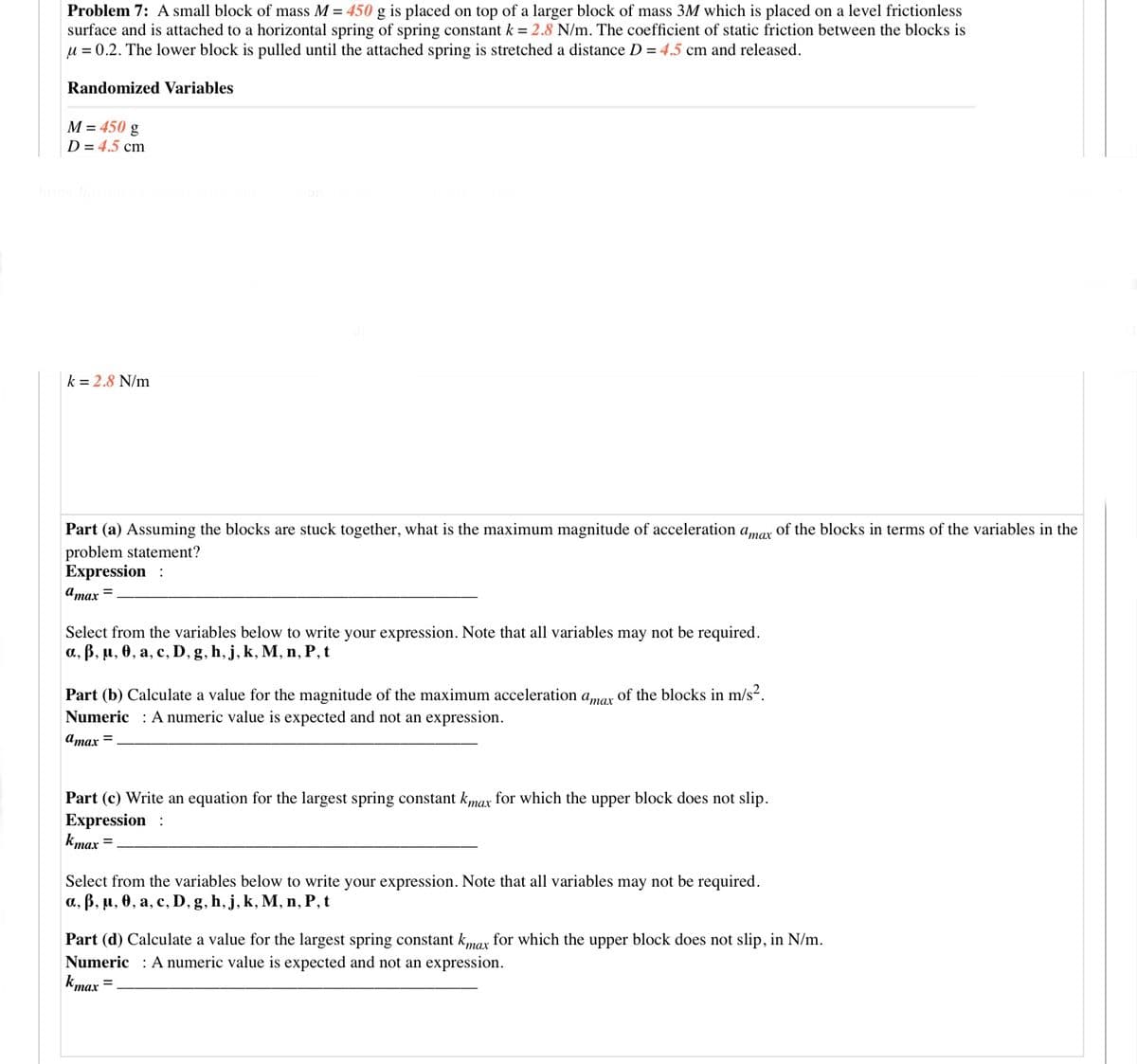Problem 7: A small block of mass M = 450 g is placed on top of a larger block of mass 3M which is placed on a level frictionless surface and is attached to a horizontal spring of spring constant k = 2.8 N/m. The coefficient of static friction between the blocks is u = 0.2. The lower block is pulled until the attached spring is stretched a distance D = 4.5 cm and released. Randomized Variables M = 450 g D = 4.5 cm k = 2.8 N/m Part (a) Assuming the blocks are stuck together, what is the maximum magnitude of acceleration amar of the blocks in terms of the variables in the problem statement? Expression : amax = Select from the variables below to write your expression. Note that all variables may not be required. a, ß, pu, 0, a, c, D, g, h, j, k, M, n, P, t Part (b) Calculate a value for the magnitude of the maximum acceleration amar of the blocks in m/s?. Numeric : A numeric value is expected and not an expression. amax = Part (c) Write an equation for the largest spring constant kmax for which the upper block does not slip. Expression : kmax = Select from the variables below to write your expression. Note that all variables may not be required. a, B, u, 0, a, c, D. g, h, j, k, M, n, P, t Part (d) Calculate a value for the largest spring constant kmax for which the upper block does not slip, in N/m. Numeric : A numeric value is expected and not an expression. kmax =
Problem 7: A small block of mass M = 450 g is placed on top of a larger block of mass 3M which is placed on a level frictionless surface and is attached to a horizontal spring of spring constant k = 2.8 N/m. The coefficient of static friction between the blocks is u = 0.2. The lower block is pulled until the attached spring is stretched a distance D = 4.5 cm and released. Randomized Variables M = 450 g D = 4.5 cm k = 2.8 N/m Part (a) Assuming the blocks are stuck together, what is the maximum magnitude of acceleration amar of the blocks in terms of the variables in the problem statement? Expression : amax = Select from the variables below to write your expression. Note that all variables may not be required. a, ß, pu, 0, a, c, D, g, h, j, k, M, n, P, t Part (b) Calculate a value for the magnitude of the maximum acceleration amar of the blocks in m/s?. Numeric : A numeric value is expected and not an expression. amax = Part (c) Write an equation for the largest spring constant kmax for which the upper block does not slip. Expression : kmax = Select from the variables below to write your expression. Note that all variables may not be required. a, B, u, 0, a, c, D. g, h, j, k, M, n, P, t Part (d) Calculate a value for the largest spring constant kmax for which the upper block does not slip, in N/m. Numeric : A numeric value is expected and not an expression. kmax =
Classical Dynamics of Particles and Systems
5th Edition
ISBN:9780534408961
Author:Stephen T. Thornton, Jerry B. Marion
Publisher:Stephen T. Thornton, Jerry B. Marion
Chapter4: Nonlinear Oscillations And Chaos
Section: Chapter Questions
Problem 4.23P
Related questions
Question
Please answer question 7

Transcribed Image Text:Problem 7: A small block of mass M = 450 g is placed on top of a larger block of mass 3M which is placed on a level frictionless
surface and is attached to a horizontal spring of spring constant k = 2.8 N/m. The coefficient of static friction between the blocks is
u = 0.2. The lower block is pulled until the attached spring is stretched a distance D = 4.5 cm and released.
Randomized Variables
M = 450 g
D = 4.5 cm
k = 2.8 N/m
Part (a) Assuming the blocks are stuck together, what is the maximum magnitude of acceleration amar of the blocks in terms of the variables in the
problem statement?
Expression :
Amax =
Select from the variables below to write your expression. Note that all variables may not be required.
a, ß, µ, 0, a, c, D, g, h, j, k, M, n, P, t
Part (b) Calculate a value for the magnitude of the maximum acceleration amar of the blocks in m/s2.
Numeric : Anumeric value is expected and not an expression.
amax =
Part (c) Write an equation for the largest spring constant kmax for which the upper block does not slip.
Expression :
kmax =
Select from the variables below to write your expression. Note that all variables may not be required.
a., B, µ, 0, a, c, D, g, h, j, k, M, n, P, t
Part (d) Calculate a value for the largest spring constant kmax for which the upper block does not slip, in N/m.
Numeric : A numeric value is expected and not an expression.
kmax
тах
Expert Solution
This question has been solved!
Explore an expertly crafted, step-by-step solution for a thorough understanding of key concepts.
This is a popular solution!
Trending now
This is a popular solution!
Step by step
Solved in 3 steps with 4 images

Knowledge Booster
Learn more about
Need a deep-dive on the concept behind this application? Look no further. Learn more about this topic, physics and related others by exploring similar questions and additional content below.Recommended textbooks for you

Classical Dynamics of Particles and Systems
Physics
ISBN:
9780534408961
Author:
Stephen T. Thornton, Jerry B. Marion
Publisher:
Cengage Learning

Classical Dynamics of Particles and Systems
Physics
ISBN:
9780534408961
Author:
Stephen T. Thornton, Jerry B. Marion
Publisher:
Cengage Learning